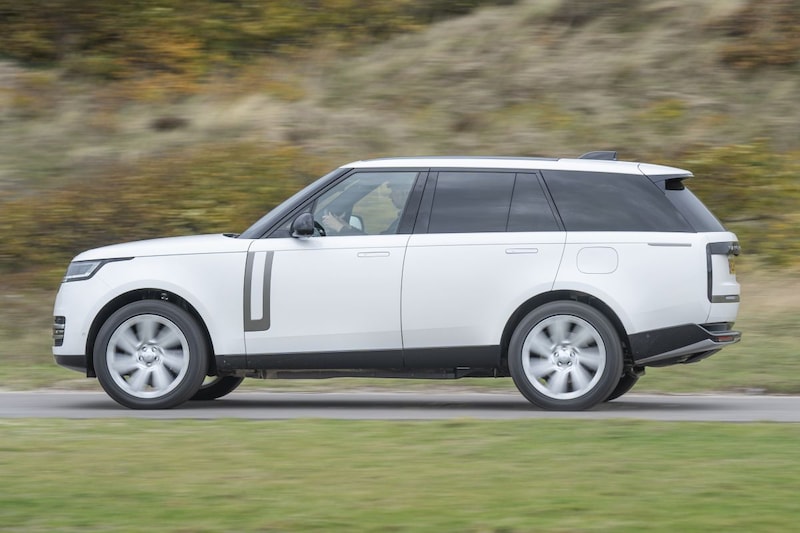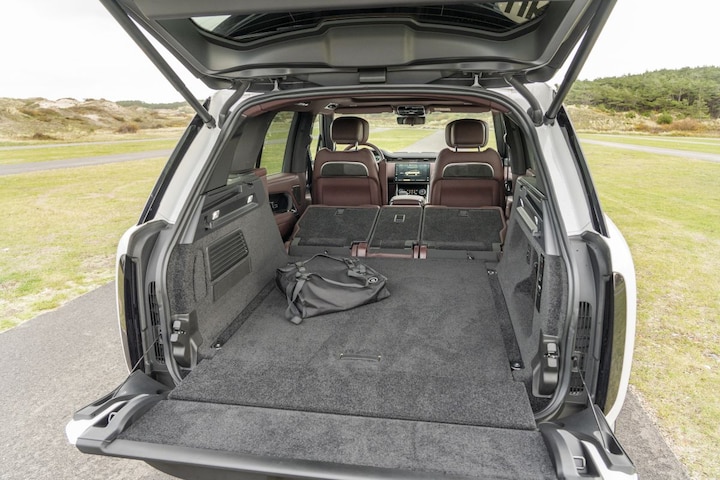PHEV is actually the only logical choice

Since 1969, the Range Rover has operated in its own universe. However, the latest generation of the British giant, which was launched in October 2021, can no longer escape electrification. An all-electric variant will even appear in 2024. But we are not there yet. For now, the plug-in hybrid Range Rover P440e is most concerned about the environment. A plug-in SUV test.
How do I recognize the new Range Rover?
First impression: the new Range Rover looks very much like its predecessor. Yet it is a completely newly developed car. The fastest way to recognize the new Range Rover is to walk to the back. There you will now find narrow, upright rear lights with dark glass, which are connected to each other via a dark, horizontal bar. Other signature features include the streamlined, flush-fitting door handles that pop out of their hiding place when the doors are unlocked and slide smoothly back into the doors when the car starts to move.
Compared to the previous model, the new Range Rover has become a total of five centimeters longer. The wheelbase increased by 7.5 centimeters. The new model is based on Jaguar Land Rover’s modular MLA-Flex platform. This also serves as the basis for the new electric Jaguar XJ, but the future of that model is still very uncertain. Like the previous Range Rover, the new generation is again offered in two length variants. The difference between the two versions is fully incorporated in the wheelbase: the LWB offers 20 centimeters extra legroom in the rear seat compared to the ‘short’ version. The long-wheelbase version is now also available as a seven-seater.

A lot of space and you can also sit on the lower part of the lid. There are even cup holders there for your tea.
What can you see and experience on board the new Range Rover?
What has not changed in any case is the sumptuous decoration of the interior. Thanks to the choice of materials – with soft leather and beautiful woodwork – and the refined level of finish, there is no doubt that the Range Rover is at the top end of the market. The largely digitized dashboard is minimalist in design: much has been concealed in the logical and fast-working infotainment system. Compared to the previous model, the British have taken a serious step forward here.
As soon as you have taken a seat behind the wheel, you notice that you are more on the seats than in them. That is also easy, because the Range Rover has a lot of space to offer in all directions. You sit like a king, both in the front and in the back, with more than enough head and legroom and a good overview thanks to the large windows.
In the Range Rover P440e, the battery of the plug-in hybrid system is concealed under the floor. As a result, you don’t have to sacrifice anything from the enormous luggage space of 818 liters. With the backrest of the rear seat (electrically) folded down, even 1,841 liters can be transported. Need even more space? The Range Rover P440e tows a 2,500kg braked trailer. This means that this plug-in hybrid version can carry up to 1,000 kilos less on the towbar than the petrol and diesel models with mild hybrid technology.

Classic elements, but also modern screens.
Can you tell us more about the Range Rover P440e powertrain?
In the front is a six-cylinder in-line engine developed by Jaguar Land Rover with a capacity of three liters. This petrol drinker is linked to an eight-speed ZF automatic transmission, which is also used in the Porsche Cayenne, for example. The Range Rover has permanent four-wheel drive, with the computer calculating an appropriate distribution of drive forces for each type of surface. A low-range transfer case is also standard.
The 400 hp petrol engine works closely with an electric motor, which delivers 143 hp. Combined, 440 hp is released to the wheels, the system torque is 620 Nm. It is true that the Range Rover P440e weighs no less than 2,695 kilos, but you are still in 6.5 seconds on the hundred. A sprint from 80 to 120 km/h takes just 3.8 seconds.
The electric motor draws its energy from a battery with a capacity of 31.8 kWh. That is quite a lot for a PHEV, according to Land Rover, a fully electric range of 113 kilometers is within reach. Calculated according to WLTP standards, the Range Rover P440e has an average consumption of 1 in 125, but you will only come close if you plug obsessively. We arrived at an average test consumption of 1 to 9.2.
Are there any other engines available in the Range Rover?
A lot, in fact. Land Rover also supplies the three-liter six-cylinder with only mild hybrid technology. Due to the higher fuel consumption and the associated CO2 emissions, this version alone is about 35,000 euros more expensive than the (more powerful) P440e with plug-in hybrid technology. This plug-in version is also available in a power variant with 510 hp, which is just under 9,000 euros more expensive than the P440e tested here.
Lovers of old-fashioned, thirsty eight-cylinders will get their money’s worth in the Range Rover P530. It is powered by a 4.4-liter V8 from BMW’s shelves. The engine delivers a maximum power of 530 hp, good for a 0-100 acceleration in just 4.6 seconds. For this version you pay a small 220,000 euros. At least!
Dieseling with a Range Rover is possible as usual with a three-liter turbo diesel, which is equipped with mild hybrid technology. The engine is available in three power variants: with 249, 300 or 350 hp.
As mentioned, a fully electric Range Rover will be added to the range in 2024.
What other SUVs does the Range Rover compare best to?
The Range Rover is an attractive alternative to the usual large SUVs from Germany – Audi Q7, BMW X5, Mercedes GLE and Porsche Cayenne. But even if you prefer to shop in a higher price range, and for example look at the Bentley Bentayga with a slanted eye, then the ‘RaRo’ is still seriously worth considering. That also applies if you need even more space and you were otherwise at the mercy of the BMW X7 or Mercedes GLS, then you might feel more at home in the long-wheelbase Range Rover LWB.
What does the Range Rover have on board as standard?
It really goes too far to discuss all trim levels in detail here. Even the most basic version, the SE, is generous in its benefits. Think of four-wheel steering, air suspension, heated front seats that can be electrically adjusted in twenty directions, an extensive audio system from Meridian with 14 speakers, leather upholstery, 21-inch alloy wheels, pixel LED headlights, automatic climate control with three temperature zones, a Pivi Pro- infotainment system…
The HSE also features digital LED headlights with adaptive beam focusing, 22-inch alloys, a clean air ionization system, front and rear seat ventilation and a head-up display. The Autobiography highlights its occupants with a panoramic roof, acoustic laminated glass, an even more complete audio system, even more adjustment options on the seats and the SV Bespoke Full Extended Leather Upgrade. And then there’s the Range Rover SV. For the ultimate luxury experience, it has some extra chrome, electrically operated doors, even more beautiful materials, active noise cancellation, seats that move in 24 directions, Executive Class Comfort Plus Seating in the back and an audio system with 34 (!) Speakers.

You can even get speakers in the headrests.
And what does the Range Rover’s safety equipment look like?
It’s already complete. Adaptive cruise control with active steering assistance, Lane Keeping Assist, Blind Spot Alert, Drowsiness Detection, a 360-degree camera, Traffic Sign Recognition and Rear Traffic Alert are standard on every Range Rover. A parking assistant and a wing mirror with a digital display of everything that happens behind you are on the option price list.
How does the Range Rover drive?
Much better than the previous model. The Range Rover is more stable and steadier than ever before. This is mainly due to the rear-wheel steering. We do notice that there is more movement in the car as the speed increases. This can be overcome to some extent by switching the air suspension to a more dynamic setting. The Range Rover never becomes sporty, comfort continues to predominate.
We take corners in the Range Rover without any problems. It remains a pleasure to control the machine high from your throne, although you do realize that you are far away from the asphalt, in centimeters and in involvement through the steering. That’s what makes it so comfortable. The Range Rover P440e we’re testing is 316kg heavier than the P400 it’s based on. In practice you hardly notice this. At a total of 2,695 kilograms, we hardly find that extra weight in the air-suspended Range Rover.
The choice of AutoWeek test coordinator Marco Gorter
Since the difference in BPM with the other versions is at least €40,000 (!), the PHEV version is actually the only motorization that can still be defended somewhat. But if you have already planned to buy a Range Rover, then you can only go for the fattest. He writes it off anyway.
.
– Thanks for information from Autoweek.nl